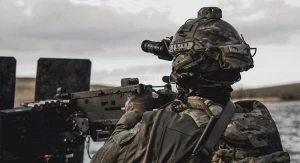
Russia plans to produce 2.7 million shells in 2024 — Ukraine's Intelligence
Vadym Skibitskyi, a spokesperson for the Defence Intelligence of Ukraine, discussed the state of Russia’s military industry, the collaborative efforts between Moscow and Pyongyang in armaments, and the significant role played by F-16 aircraft, which are a source of considerable apprehension in Russia
He shared the information in an interview with Interfax-Ukraine.
Russia’s missile production capabilities
According to the HUR spokesperson, in February 2024, Russia planned to produce 130 missiles of the Iskander, Kalibr, Kh-101, Kh-32, and Kinzhal class.
“The Russians had and still have intentions to increase production. In February, it was planned to produce 130 missiles (Iskander, Kalibr, Kh-101, Kh-32, Kinzhal). It must be said that the enemy does have plans for production, and the Russians are trying to fulfill them, even if there are restrictions on components due to the imposition of sanctions,” he explained.
He added that a center has been established in Russia to substitute foreign components, particularly electronic ones, with those manufactured domestically. Although the Russian-made components are of inferior quality, they still facilitate the production of weapons.
The spokesperson also highlighted that Russians are deploying missiles produced in the fourth quarter of 2023, straight from the assembly line. It's evident that these missiles no longer adhere to the declared specifications, showing a decline in quality.
Shell production plans
Last year, Russia produced about 2 million 122 mm and 152 mm shells. Meanwhile, in 2024, it plans to produce 2.7 million shells.
“But these are plans. We will see whether they will be realized. But this requires, first, modernization of production, reactivation or creation of new lines,” Skibitskyi explained.
According to him, Russia has already depleted all the ammunition in Belarus, leaving nothing remaining to be taken from there.
Meanwhile, Russians have already acquired 1.5 million 122 mm and 152 mm shells from North Korea. However, these ammunition units are 70-80 years old, with half of them found to be non-functional.
In exchange for the supply of shells, missiles and other weapons, Pyongyang seeks to receive military technologies from Moscow to develop its military-industrial complex.
“It gives away the old stuff, asks to increase production at home, and asks for certain technologies in return, including missile technology and submarine technology, in order to develop its defense industry. In other words, they made a bargain. They are receiving technologies from Russia.
And the most important thing here for the international community is that the DPRK is definitely asking for technologies related to nuclear weapons. And here we need to hold Russia accountable, because the whole world is fighting for non-proliferation, and Russia is openly starting to work in this direction in exchange for additional ammunition, missiles, and other weapons,” Skibitskyi stressed.
Russia’s aircraft capabilities
Currently, Russia has about 300 combat aircraft that it uses against Ukraine.
According to Skibitskyi, the F-16 is one of the means that will allow, among other things, to destroy Russian aircraft used for bombing strikes.
In that case, there will be no repetition of instances such as 75 Russian bombs raining down on Avdiivka in a single day, or the onslaught witnessed in Krynky, where the Russians launched, for instance, 35-45 bombs at one of Ukraine’s small bridgeheads.
“The Kremlin is very afraid that powerful Western equipment will come to Ukraine, so the aggressor has set itself the task of destroying both our aviation and infrastructure,” the spokesperson explained.
Wagner resurface and foreigners recruited to Russian army
Russia is forming a so-called "volunteer corps" of 18,000 people, including former Wagner mercenaries. This process is managed by Russia’s Ministry of Defense.
“They are actively involved because they have combat experience. That is, you can see them on the battlefield now. Their approach is the same as that used by Wagner in Bakhmut. It is constant assault and achieving results at any cost,” said Skibitskyi.
He also mentioned that foreigners recruited by Russia, including Africans and Syrians, often go to war with the intention of escaping at the earliest opportunity and subsequently making their way to Europe.
- News













































